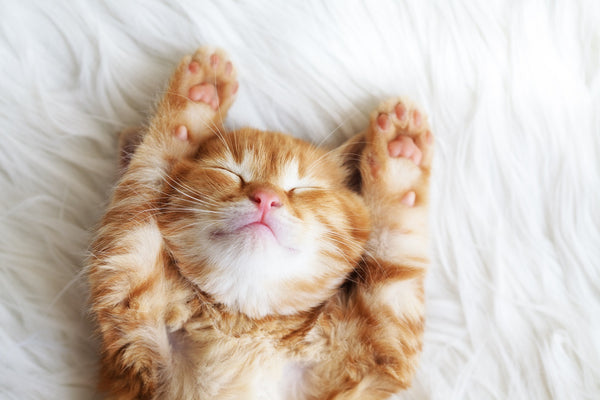
Quirky Cat Behavior: From Making Muffins to Spraying - A Bit of Insight!
(by Dr. Iuliana Mihai, DVM) We all love cats! Cats are sweet little creatures that never stop making us laugh! They make funny faces when they smell something strange, they forget to close their mouth, they like to make muffins, and so on. But have you ever wondered what all these behaviors represent, which in our eyes may seem odd, but for them, they are perfectly normal?
A conversation with your cat is not possible, but there are many ways to know how it feels, and those ways include "strange" behaviors, such as kneading (making muffins), rubbing against our feet, vocalization, imitating a baby, chewing, excessive grooming, spraying, jumping and running all over the house, sleeping in odd positions, sitting on your things, watching over you during night time, attacking your hand or foot, touching our face (especially our nose), etc.
If you want to know more about these behaviors, check our tips to become an expert in reading your cat's behavior.
Making Muffins
Kneading, or “making muffins”, happens in the same place, repeatedly. This behavior is usually accompanied by an intense purring. When your cat kneads you, it uses an instinct that it developed from the first days of life. When kittens suckle from their mother, they massage around the nipple to stimulate milk production. This habit does not disappear when cats become adults; they use it when they are satisfied or feel the need to calm down.
Rubbing Against Our Feet
Cats show their affection for us in many ways, and rubbing against our feet is one of them. Through this behavior, they mark us with their scent. The scented glands are found in their paws or around the mouth and chin. Cats can also rub against furniture or other surrounding objects, marking their territory with their smell. By marking us, cats let the whole world know that we belong to them. In other words, by releasing the pheromones from the head area, the cat shows that it is proud we are its owner.
Vocalization
Meowing is another way cats communicate with us. This behavior can occur at any time during the day, but especially at night, and is most often considered normal. Vocalization can occur from several causes such as senility in cats, boredom, seeking attention, pain, etc. The Siamese cat breed is more naturally vocal than other breeds.
If all of a sudden, your cat starts to "communicate" more than normal or in a different way than usual, many times, this is a sign that something is wrong. For example, cats that vocalize when using the litter box or when eliminating usually are experiencing discomfort or pain.
Another way cats communicate is vocalization similar to crying like a baby. Cats are very similar to infants and learn to communicate with us in the same way as babies do - through listening and imitation. Thus, when the cat meows like a baby, it imitates the childish way you talk to it. People tend to talk to their pet like a baby, in a more childish, caressing way. The cat wants nothing more than to be on the same wavelength as you.
There are times when your fluffy pet seems to be talking, and you have certainly heard the sound your cat makes when it looks like it’s talking between its teeth. In those moments, your cat is so frustrated because it can't obtain something it wants. The sound, similar to that made by a fawn, is determined by excitement and/or exasperation. Although the sound is strange, it is completely normal, and it will vanish with the disappearance of the source of frustration.
For example, your cat is likely to let you know that it is meal time by meowing, and once it is fed, will express contentment with purring or affectionate blinking.
Your feline friend will be extra content after enjoying one of Spring Naturals’ dinners for cats. Our grain-free dinners for cats contain all-natural meats, eggs, fruits, and vegetables for a heart-healthy, low carb diet.
Spring Naturals is the original low-glycemic, limited ingredient cat food crafted to be the most nutritionally balanced and complete recipe available. That’s why we call it dinner. Browse our selection of nutritious foods for cats here.
Chewing
Although cats cannot chew like dogs, they still do some damage with their teeth. This behavior can be caused by boredom, teeth eruption in the kitten's gums, aggression, nutritional deficiencies, or when they like the texture or the taste. It is an instinctive habit.
Chewing in cats often provides the stimulation they need to get over boredom. In other cats, this behavior has been associated with OCD.
Excessive Grooming (Over-Grooming)
The cat's tongue is covered with hundreds of hook-like structures (papillae). Cats have about 470, and humans have over 9,000 taste buds. The papillae are directed backward and are used for care and cleaning. Grooming in cats is usually a singular task, but there are times when they groom each other (for example, when the mother is grooming her kittens). Excessive grooming in cats has 2 main causes: behavioral when the cat over-grooms to relieve stress (medically it is called psychogenic alopecia), and medical when the cat has external parasites or allergies, which often translate into dermatitis.
Spraying
This behavior is another form of marking the territory. The cat turns its back on a vertical surface, it will raise its tail, and spray with urine - the tail often trembles when the cat adopts this behavior. Spraying is not the same as urinating. When urinating, cats squat, and eliminate on any horizontal surface.
Sterilization does not stop cats from spraying their territory; it only changes the smell of urine (especially in males) and reduces the motivation for spraying. Studies show that about 10% of sterilized males and 5% of sterilized females will continue to spray and mark their territory with urine. This behavior occurs most often in households with more cats because they will feel the need to mark their territory more often. This behavior can also be observed in households with a single cat, but less often.
Jumping and Running All Over the House (Especially At Night)
It has certainly happened at least once that your cat has started running, out of the blue, for no reason and without a certain destination, hitting things around the house. Since cats sleep most of the day, a significant amount of energy accumulates that must be released. It is preferable to play with your cat to release this energy. But if you don't have time for it, the cat will burn energy by randomly running around the house, or jumping on various things, especially at night time.
Laying and Sleeping in Odd Positions
When your cat sits on its back with its legs apart, it means that it is comfortable. In this position it is relaxed and happy, it trusts those around it, and it feels safe around you. Specialists in feline behavior say that when a cat exposes its belly and thorax, which house the vital organs, it feels safe and trusts us. Cats also adopt this position on hot summer days; they expose their bellies to cool off.
Our fluffy friends also like to roll on their backs. Rolling around the house on their back is another way to discharge the accumulated energy, or even to get rid of the nervousness they have. This behavior makes your cat feel relaxed.
Sitting on Your Things
Cats love to sit on top of our things, and especially on freshly washed clothes or laptops. From books, clothes, phones, or the computer keyboard, you can think of a lot of things on which your cat sits. By sitting on your things, your cat, on the one hand, knows that it will receive all your attention, and on the other hand it feels safe. If you have an activity that relaxes you, by the simple fact that it is next to you, your cat also relaxes. Also, the cat wants to leave its smell on you and your things, especially on freshly washed clothes.
Watching Over You During Nighttime
Legend has it that the ancestors of cats, the African wild cat, were nocturnal animals. Thus, it is not surprising that your cat watches over you at night like an owl when you sleep. Play with your
cat in the evening or before bedtime to make sure it doesn't keep you awake at night. This way you will make your cat tired so that it can sleep at night, instead of wandering around the house.
Attacking Your Hand or Foot
When your cat attacks your hand, foot, or slipper it simply instinctively practices hunting (jumping, catching, and biting). For it, this gesture can also be at play. If you are attacked, enter its game, or distract it with a laser toy. Do not let your cat bite you, and do not encourage this behavior. Enter its game by taking its mind off the bite - play with it with cat toys like fishing poles, balls, feathers, laser toys, etc.
Cats bite for several reasons: they are stressed, nervous, they’re playing, or simply because they can. Biting is an instinct in cats, so you shouldn't be surprised if at one point it grooms you and the next it bites you. No matter how badly it bites you, try not to yell at your cat. It is best to move away from it.
Touching Our Face (Especially Our Nose)
It is known that cats are very curious animals by nature, and part of their curiosity focuses on humans. They want to smell your face, touch noses, or pick up your scent.
Cats do this with other cats, and especially with those with whom they have already made a connection - the phenomenon is called allorubbing and occurs when two cats rub their heads, bodies, and tails together. Specialists have come to the conclusion that this type of interaction between cats can be similar to hugs between people - hugging facilitates and maintains friendly social relationships.
Final Thoughts
If you couldn’t before, hopefully you can now analyze your cat’s quirky behaviors and have a better understanding of their needs, feelings, and wants - or in some cases, demands.
Dr. Iuliana Mihai, DVM, Masters In Small Animals And Equines Pathology
Iuliana graduated from the University of Agronomical Sciences and Veterinary Medicine in 2012, Romania. She has a Master’s degree in Small Animal and Equines Pathology and a strong affinity for Veterinary Parasitology and Laboratory. In 2013 she started her Ph.D. in epithelial cancer in dogs and cats. She volunteered at the faculty’s clinic at her 3rd year of study, and continued her career in small animal pathology and laboratory. She has one cat and eleven rats. Her interests outside of work include traveling, writing, and crafting.

Post a Comment!